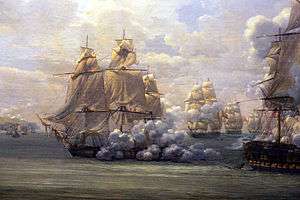Raking fire


In sailing naval warfare, raking fire is fire directed parallel to the long axis of an enemy ship from ahead or astern. Although each shot is directed against a smaller target profile than by shooting broadside and thus more likely to miss the target ship to one side or the other, an individual cannon shot that hits will pass through more of the ship, thereby increasing damage to the hull, sails, cannon and crew. In addition, the targeted ship will have fewer (if any) guns able to return fire. A stern rake tends to be more damaging than a bow rake because the shots are not deflected by the curved (and strengthened) bow,[1] and because disabling the exposed rudder at the stern would render the target unable to steer and thus manoeuvre. However, achieving a position to rake a single enemy ship was usually very difficult unless the opponent was unable to manoeuvre due to damage to the sails or rudder; it was easier if a ship was constrained by its position in the line of battle.
The effectiveness of this tactic was demonstrated at the Battle of Trafalgar. Admiral Nelson's HMS Victory, leading the weather column of the British fleet, broke the French line just astern of the French flagship Bucentaure, and just ahead of Redoutable. Victory raked the Bucentaure's less protected stern killing 197 and wounding a further 85, including the Bucentaure's captain, Magendie. Admiral Villeneuve was lucky to survive, and although he was not captured for three hours, the raking put Bucentaure out of the fight.
References
- ↑ Wills, Sam (2008). Fighting at Sea in the Eighteenth Century: The Art of Sailing Warfare. Woodbridge UK: Boydell Press. p. 143. ISBN 978-1-84383-367-3. Retrieved December 5, 2014.